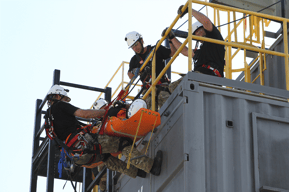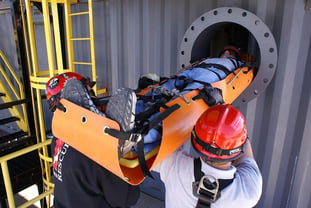Q&A: The Role of Spine Boards in Rescue
 QUESTION:
QUESTION:
What is the role of a spine board in emergency medical response, specifically when dealing with confined space and high-angle rescues?
NOTICE: It is extremely important to follow local protocols in providing emergency medical care.
ANSWER:
For many years, spine boards have been a staple in emergency medical responses for moving and transporting patients with suspected spinal injuries. In rescue operations, spine boards do an excellent job of immobilizing the patient as well as providing a means of transporting the patient from one location to another.
The mindset of always using a backboard may not be the best for every patient - in fact, there is a risk of harm.
 Studies in emergency medicine have brought a critical perspective to the use of spine boards. While they are indispensable in certain situations, these studies highlight the negative effects of prolonged immobilization on a hard surface. Issues such as pressure sores, discomfort, and breathing problems have been reported, suggesting that the use of spine boards should be carefully considered and not automatically applied to all EMS cases.
Studies in emergency medicine have brought a critical perspective to the use of spine boards. While they are indispensable in certain situations, these studies highlight the negative effects of prolonged immobilization on a hard surface. Issues such as pressure sores, discomfort, and breathing problems have been reported, suggesting that the use of spine boards should be carefully considered and not automatically applied to all EMS cases.
The approach to using spine boards is becoming more selective and nuanced. Medical professionals now advocate for a protocol known as "Spinal Motion Restriction," which tailors the immobilization method to the specifics of the injury and the rescue context. This might involve using devices like C-collars or employing techniques that minimize movement without the complete rigidity of a spine board, especially if the rescue scenario allows for careful handling.
Team protocols and procedures should stress the importance of not causing additional harm through interventions.
The decision to use a spine board should be based on a thorough assessment of the injury, the patient's condition, and the rescue environment. Especially due to research that indicates unnecessary use may lead to complications that could potentially outweigh the benefits.
In rescue, spine boards still provide an excellent means of securing a sick or injured patient. It provides a rigid means of transport offering protection of the patient's neck and back. This can be particularly vital in scenarios like high-angle rescues or extractions from confined spaces, where the risk of challenging movements is significant. 
While spine boards are a critical tool in certain rescue operations, their use should be judicious and tailored to each unique situation. As emergency response techniques evolve, so will the strategies for spinal protection, ensuring that patient safety and outcome remain at the forefront of rescue operations.




